
Angular2
Presentation from an AngularJS (v1) dev
DAVIN Kevin
- Full-stack Dev
- Agile Addict
- Main commiter on AngularJS's libraries
- Angular and other tech Former
Summary

Since NG-Europe 2014 and the announcement of Angular2 , a lot of change have been made...
RIP of AngularJS principle

Why calling it Angular2 after all ?
The core is still "Angular"
Keep only the good parts of the original Framework
The v2 of Angular is React ?

A lot of people was discourage by the change
The AngularTeam work hard to improve Migration Path
AtScript...?
An extension of Javascript should have been the reference language

But Google/Microsoft teams-up to improve TypeScript
It's not backward-compatible...
It's True but the AngularTeam have something to help the migration...
Angular1 is dying ?
No, It will be supported during two years after the release of Angular2
And your app won't stop working after this...
One framework or many framework ?

AngularJS is a macro-framework with :
- Dependency Injection
- Digest Cycle
- Module Dependency
- Directive for everything...
Angular2 is a m*cro-framework
- DI.js (Angular2 dependency injector)
- Zones.js
- Observable
- SystemJs
- Native browser API
Dependency Injection

Help to conserve SOLID principle in application
In angular1
angular.module('myApp', [])
.constant('Engine', function(){}).
.constant('Tires', function(){}).
.service('Car', Car);
function Car(Engine, Tires){...};
Car.$inject('Engine', 'Tires');- Duplication of "code"
- Singleton for the whole App
- Namespace collision
DI in Angular2
In ES2015
import { Inject } from 'angular2/core';
class Car {
constructor(@Inject(Engine) engine, @Inject(Tires) tires) {}
}In TypeScript
class Car {
constructor(engine: Engine, tires: Tires) {}
}The Injector
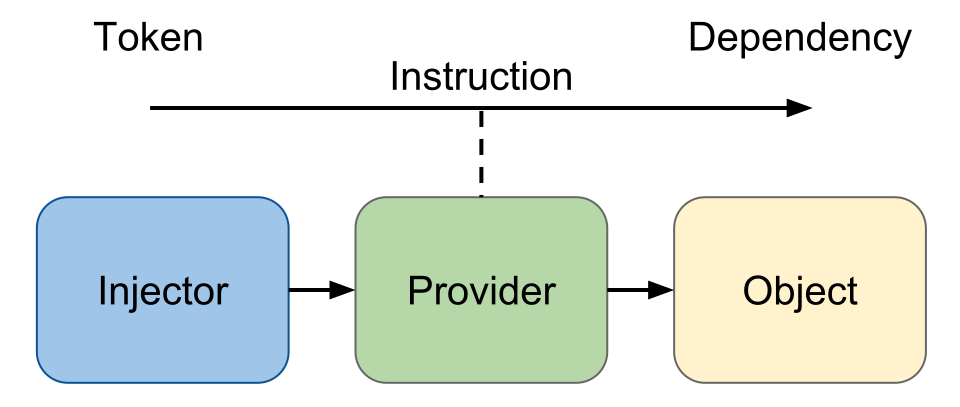
So it's just a Map<Token, Provider>
Providing Injectable
import { Injector } from 'angular2/core';
...
let injector = Injector.resolveAndCreate([
Car,
Engine,
Tires
]);
let car = injector.get(Car);import { Injector, provide } from 'angular2/core';
...
let injector = Injector.resolveAndCreate([
provide(Car, {useClass: Car}),
provide(Engine, {useClass: Engine}),
provide(Tires, {useClass: Tires})
]);Multiple sort of injectable
import { Injector, provide } from 'angular2/core';
...
let injector = Injector.resolveAndCreate([
Car, // Class as a Provider
provide(Car, {useClass: Car}), // Full description of Provider, allow aliases
provide(Car, {
useFactory : (engine, tire) => new Car(engine, tire),
deps : ['Engine', 'Tire']
}), // Provide Car from Factory
provide(Tire, {useValue: "Tire"}), // Use Value
SuperEngine,
provide(Engine, {useExisting : SuperEngine }), // Use Alias
]);Injector(s)
Singleton only inside the same injectors
import { Injector } from 'angular2/core';
let injector = Injector.resolveAndCreate([Engine]);
let childInjector = injector.resolveAndCreateChild([Engine]);
injector.get(Engine) === injector.get(Engine);
injector.get(Engine) !== childInjector.get(Engine);Inheritance between Injector

Zones.js
Zones are simply an Execution context for Javascript
Zones.js
Zones are simply an Execution context for Javascript
It helps to handle asynchronous code in JS
Extract from Dart Lang, alternative to Domains in NodeJS
Javascript 101
function cf(name) { return function() { console.log(name); } };
var a = cf('a'), b = cf('b'), c = cf('c'), d = cf('d');
a();
setTimeout(b, 0);
setTimeout(c, 0);
d();Results to
a
d
b
cAll the async tasks are added to the event queue and executed when other tasks are finished
How long does it take ?
start();
a();
setTimeout(b, 0);
setTimeout(c, 0);
d();
stop();Results :
// Start
a
d
// Stop
b // Missed
c // MissedWhat need to be done ?

What need to be done ?

Why are we talking about this ?
Let's consider a framework, for example AngularJS with this:
var $rootScope;
zone
.fork({
afterTask : function() {
$rootScope.$digest();
}
})
.run(function() {
angular.bootstrap(document, aModule);
$rootScope = angular
.element(document)
.injector()
.get('$rootScope');
});Bonus
Observables
Definition
“Observables are lazy event streams which can emit zero or more events, and may or may not finish.”
How many time did you write this ?
$scope.$watch('foo.bar', (newVal, oldVal) => {
...
});Or this ?
$scope.$watch('foo.bar', (newVal, oldVal) => {
if (newVal.length <= 0)
return;
let firstTransformation = removeSpaces(newVal);
let secondTransoformation = firstTransformation.toUpperCase();
$scope.result = thirdTransformation;
});RxJS

Simpler !
We can write our previous $watch like this...
foo.bar$ // An Observable
.filter(v => v.length > 0)
.map(v => removeSpaces(v))
.map(v => v.toUpperCase())
.subscribe(
v => $scope.result = v /* An Observer */
);
And we have a lot of operators !
- create
- range
- using
- from
- of
- toPromise
- toMap
- toSet
- toArray
- amb
- combineLatest
- concat
- startWith
- merge
- repeat
- withLatestFrom
- zip
- publish
- replay
- aggregate
- average
- count
- max
- min
- reduce
- sum
- debounce
- interval
- filter
- map
- elementAtOrDefault
- flatMap
- findIndex
- first
- pluck
- select
- single
- take
- takeLast
- where
- buffer
- groupBy
- join
- windowd
- do
Any documentation ?
Yes, and it's very fun !

Good to know...
Observable are immutable, composable and reusable
let obs$ = Rx.Observable.from(1, 2, 3, 4, 5);
obs.subscribe(x => console.log(x)); // 1, 2, 3, 4, 5
let evenObs$ = obs.filter(x => x%2 == 0 ));
evenObs$.subscribe(x => console.log(x)) // 2, 4
evenObs$.map(x => x*2).subscribe(x => console.log(x)) // 4, 8

SystemJS
A polifyll for ES2017 (?) module loader
Module dependency done easy
In AngularJS (it's so 2009...)
angular.module('FooModule', [
'BarModule',
'anotherModule'
]);In ES2015 & SystemJS
import { BarModule } from './Bar.comp';
import { AnotherComp } from './another.comp';Simple to maintain !
Is it worth it ?
Angular2 is fully modular
Reduce the size of the app depending of what your app need
And we deserve better than... this !
(function (global, factory) {
typeof exports === 'object' && typeof module !== 'undefined' ? factory() :
typeof define === 'function' && define.amd ? define(factory) :
(factory());
}(this, function () { 'use strict';
function myAwesomModule() {
...
}
}));Only SystemJS ?
No... you can use what you want
For information...
- Webpack 2 will try to fill the gap between Webpack 1 and JSPM/Rollup
- JSPM uses Rollup.Js for the build and tree-shaking
- The AngularTeam uses Rollup to build Angular2 right now
An after jQuery-World
Born in 2006 and help a lot of Web developers...
In AngularJS, we use jQuery Lite
Good fallback to do more in a complicated world

But now, we need to be serious because...

HTML5 API's are just enough !

CSS3 query Selectors
let firstClass = document.querySelector('.some-class');
let allOfClass = document.querySelectorAll('.some-class');CSS class manipulation
let elem = document.querySelector('#some-element');
elem.classList.add('some-class'); // Add class
elem.classList.remove('some-other-class'); // Remove class
elem.classList.toggle('some-other-class') // ...toggle...
elem.classList.contains('some-third-class') // Does it have some class ?Same thing on inline style...
elem.style.color; // Get a CSS attribute
elem.style.color = 'rebeccapurple'; // Set a CSS attribute
elem.style.minHeight; // Get a CSS attribute
elem.style.minHeight = '200px'; // Set a CSS attributeWorking with Event
let elem = document.querySelector('#some-element');
elem.addEventListener('click', () => console.log('clicked'), false);
elem.addEventListener('customEvent', anotherFunction, false);Navigating into the dom
let elem = document.querySelector('#some-element');
let parent = elem.parentNode;
let childs = elem.childNodes;
let specificChild = elem.querySelector('anotherClass');
let specificChilds = elem.querySelectorAll('anotherClass');And about perf ?

Many Languages

Simpler...

Future proof
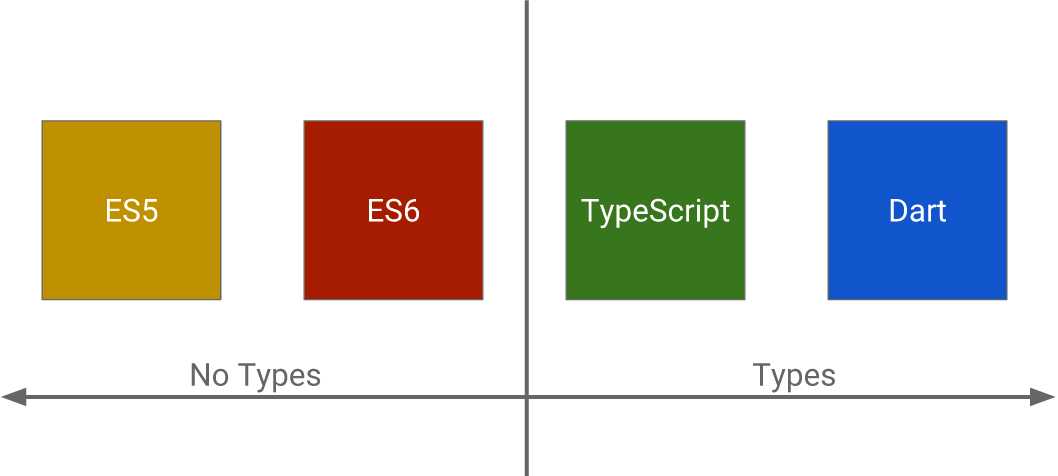
Type and IDE help
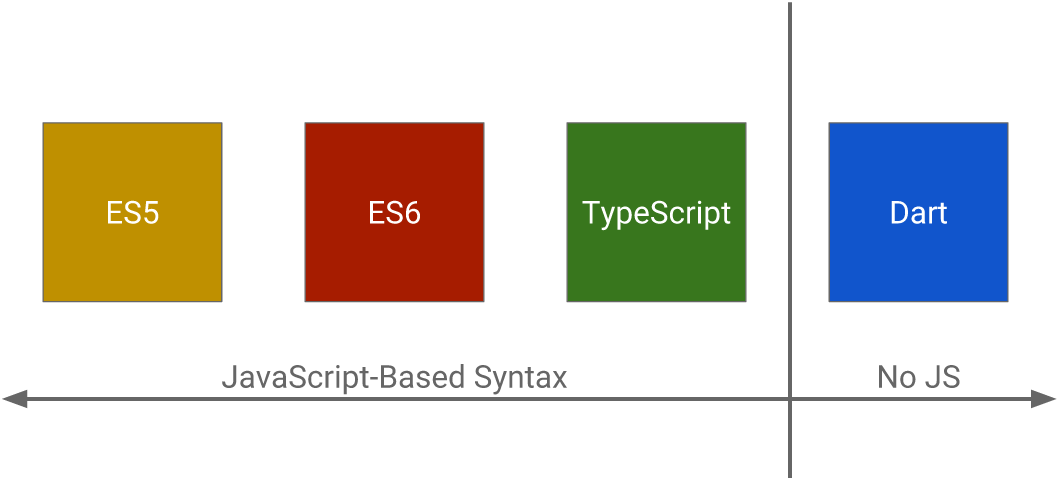
JS based, vector of innovation

So you can write Angular2 in Plain Old Javascript
var TodoComp = ng
.Component({
selector: 'todo',
templateUrl: '../partials/todo.html'
})
.Class({
constructor: function (heroService, routeParams) {}
select(todo){...}
});But, it isn't as fun as evolved JS
Or with Type and Decorators !
@Component({
selector: 'todo',
templateUrl: '../partials/todo.html'
})
export class TodoComp {
constructor(
private heroService: HeroService,
private routeParams: RouteParams
){}
select(todo : Todo) : Boolean {...}
}Angular2
All is about Component
EVERYWHERE !
An app are just some buildings block
A Component is
Template + Controller (+ optional RouteConfig)
Template
<div>My title is {{ title }}</div>Property Bindings
No more ng-x directives
Instead, we use standard HTML for property binding
<h3 ng-hide="vm.isHidden" ng-class="{active : favoriteHero === hero }" >
Your favorite hero is: {{ vm.favoriteHero }}
</h3>becomes...
<h3 [hidden]="isHidden" [class.active]="favoriteHero === hero" >
Your favorite hero is: {{ favoriteHero }}
</h3>Event Bindings
Really no more ng-x directives
Again, we use standard HTML for event binding
<input ng-click="vm.send(foo)">Click me !</input>becomes...
<input (click)="send($event)">Click me !</input>And the 'magical' two-way binding ?
It disappears, so we have to do it manually
<input [value]="hero.firstName"
(input)="hero.firstName=$event.target.value" >
NgModel Directive
The API evolves to introduce a syntax for the two-way binding in latest Alpha
<input [(ngModel)]="hero.firstname">This syntax is a mix between property and event bindings
Structural Directive
All the directive inducing a dom modification outside of the current element are called Structural Directive
- ng-if
- ng-switch
- ng-repeat
The syntax is a kind of special...
<p *ngIf="condition">
condition is true and ngIf is true.
</p><tr *ngFor="let movie of movies">{{movie.name}}</tr>But Why ?
Using HTML Template Element
<template>
<div>A super template !</div>
</template>This template isn't rendered by the browser but can be used
The asterisk (*) effect
<p *ngIf="condition">
A super template !
</p><template [ngIf]="condition">
<p>
A super template !
</p>
</template>So, the * is just a syntaxic sugar
And we can write our own Structural Directive !
Local template variable
We can define a template variable associated to a dom element
<video #player src="foo.mp4"></video>
<button (click)="player.play()"></button>Controller
Still holding all the logic of the component
And compared to Angular1, a component is a tiny "App"
Shell up a Component Declaration
import { Component } from 'angular2/core';
@Component({
selector: 'todo',
template: `<h1>{{ title }}</h1>`
})
export class TodoComp {
public title : String = 'A super presentation !!';
}Using a service in my component
import { Component } from 'angular2/core';
import { MyService } from './myservice';
@Component({
selector: 'todo',
template: `<h1>{{ title }}</h1>`
})
export class TodoComp {
public title : String = 'A super presentation !!';
constructor(private _myService : MyService){} // DI in constructor
}
Using a service in my component
import { Component } from 'angular2/core';
import { MyService } from './myservice';
@Component({
selector: 'todo',
template: `<h1>{{ title }}</h1>`,
providers : [ MyService ] // Do you remember the injector part ?
})
export class TodoComp {
public title : String = 'A super presentation !!';
constructor(private _myService : MyService){} // DI in constructor
}And now a sub component...
import { Component } from 'angular2/core';
import { MyService } from './myservice';
@Component({
selector: 'todo',
template: `
<h1>{{ title }}</h1>
<emitter></emitter>
`,
providers : [ MyService ]
})
export class TodoComp {
public title : String = 'A super presentation !!';
constructor(private _myService : MyService){}
}
And now a sub component...
import { Component } from 'angular2/core';
import { MyService } from './myservice';
import { EmitterComponent } from "./emitter.component";
@Component({
selector: 'todo',
template: `<h1>{{ title }}</h1> <emitter></emitter>`,
directives : [ EmitterComponent ] // Inclusion of all subComp needed
providers : [ MyService ]
})
export class TodoComp {
public title : String = 'A super presentation !!';
constructor(private _myService : MyService){}
}Why so complicated ?
- Allow Singleton / Multiple service for part of app
- Avoid name conflict in html
- All system handle in same place !
Now, Components have an intuitive LifeCycle
- OnChange - input|output binding value changes
- OnInit - after the 1st OnChange
- DoCheck - dev's custom change detection
- AfterContentInit - after comp content initialized
- AfterContentChecked - after every check of comp content
- AfterViewInit - after comp's view(s) are initialized
- AfterViewChecked - after every check of a comp's view(s)
- OnDestroy - just before destruction
And we can use Interface to declare it
import { Component } from 'angular2/core';
import { MyService } from './myservice';
import { EmitterComponent } from "./emitter.component";
@Component({
selector: 'todo',
template: `<h1>{{ title }}</h1> <emitter></emitter>`,
directives : [ EmitterComponent ] // Inclusion of all subComp needed
providers : [ MyService ]
})
export class TodoComp implements OnInit {
public title : String = 'A super presentation !!';
constructor(private _myService : MyService){}
ngOnInit() { console.log('The Component is initialised'); }
}No more headache with [pre|post]link and compile
Communication
We have now a component, but we want to communicate with other element
How could we do that without any DDO ?
Again, all is in component
Input(s)
import {Component, Input} from 'angular2/core';
@Component({
selector: 'counter'
template: `...`
})
export class CounterCmp {
@Input() counterValue = 0;
}
<counter [counterValue]="10"></counter>Inputs(s) with Alias
import {Component, Input} from 'angular2/core';
@Component({
selector: 'counter'
template: `...`
})
export class CounterCmp {
@Input('start') counterValue = 0;
}
<counter [start]="10"></counter>Output(s) as Events !
import {Component, Input} from 'angular2/core';
@Component({
selector: 'counter'
template: `...`
})
export class CounterCmp {
@Input('start') counterValue = 0;
@Output() stateEmitter = new EventEmitter<State>();
}
<counter [start]="10" (stateEmitter)="show($event)"></counter>Output(s) with alias too (of course...)
import {Component, Input} from 'angular2/core';
@Component({
selector: 'counter'
template: `...`
})
export class CounterCmp {
@Input('start') counterValue = 0;
@Output('finish') stateEmitter = new EventEmitter<State>();
myState : State = { numberOfStop : 0, startDate : Date.now(), finishDate : null };
finish() {
this.stateEmitter.emit(myState);
}
}
<counter [start]="10" (finish)="show($event)"></counter>Bi-Directional communication
- [Input] as data-binding
- (Output) as event-binding
No more of
<foo bar="val"></foo>
<foo bar="{{ val }}"></foo>
<foo bar="val()"></foo>
<foo bar="val"></foo> <!-- the word 'val', not the value'Service
It's where the logic of your app should be...
Question

And you think Angular2 is more complicated ?
We can declare a service like this
export class MyService{}providers : [ MyService ]@Injectable
Just need one decorator to allow DI
import {Injectable} from 'angular2/core';
@Injectable()
export class MyService{
constructor(private _http : http){}
}Major change everywhere...
We don't have time to deep dive on everyone, but we can mention it
ComponentRouter
Why we need a new Router ?
A `component` logic lead to a Component Router
Ng-Route was too simple

The UI-Router alternative was quite popular
The Router provide now
- Named Route
- Dedicated @RouteConfig and Directive
- Hierarchical Route
- Concurrent Route
Configurable Change-Detection
- 1 digest cycle allow to treat the whole app
- You can alter the Change detection behavior
- Optimized for immutability
View Encapsulation mode
We can encapsulate everything, and we can do it by multiple way
For a given Component
import {ViewEncapsulation} from 'angular2/core';
@Component({
selector: 'comp',
templateUrl: '<div class="my-comp">An encapsulated comp</div>',
styles: [`.my-comp { background: green; }`],
encapsulation: ViewEncapsulation.Emulated
})
class Comp {}Emulated
Which is the default encapsulation system
<head>
<style>.my-comp[_ngcontent-1] {background: green;}</style>
</head><comp _ngcontent-0 _nghost-1>
<div class="my-comp" _ngcontent-1>
An encapsulated comp
</div>
</comp>Native
Which uses the Shadow-DOM
encapsulation: ViewEncapsulation.Native<comp>
#shadow-root
| <style>
| .my-comp { background: green; }
| </style>
| <div class="my-comp">An encapsulated comp</div>
</comp>None
Take care of Side effect !
encapsulation: ViewEncapsulation.None<head>
<style>.my-comp {background: green;}</style>
</head><comp _nghost-1>
<div class="my-comp">
An encapsulated comp
</div>
</comp>Angular-CLI
Derived from ember-cli
$ ng new project
$ ng generate component my-new-component
$ ng build
$ ng test
$ ng e2e
$ ng serverBeyond the browser...
The JS will live out the window element
A new Era !
The progressive Web-App era
Web-Worker

A way to do 'heavy' calculation in another thread
Service-Worker
After Mobile First, Offline-First

Cache

Offline

Synchronisation
Universal Angular

Also know as Server-Side-Rendering
- Increase performance at first load
- Help for SEO
Angular2 is built upon this principle
import {bootstrap} from 'angular2/platform/browser';
import {AppComponent} from './app.component';
bootstrap(AppComponent);
Migration ?
A migration Path exists
The Angular Team works very hard around a way to transform our AngularJS application in Angular2 App
UpgradeAdapter
A module allowing to Upgrade and Downgrade
elements of Ng1 and Ng2
- Allow new syntax in template
- Synchronize $rootScope.$digest with Zones
- Create a bridge between DI of two systems
Downgrading from ng2 to ng1
import {UpgradeAdapter} from 'angular2/upgrade';
var adapter = new UpgradeAdapter();
var app = angular.module('myApp', []);
adapter.bootstrap(document.body, ['myApp']);app.directive('productDetail',
adapter.downgradeNg2Component(ProductDetail));Upgrading from ng1 to ng2
@Component({
selector: 'product-list',
directives: [
adapter.upgradeNg1Component('productListItem')
],
template: `<h2>Product List</h2>
<product-list-item [product]="product"></product-list-item>`
})
class ProductList {
@Input() products: Product[];
...
}How do we proceed ?
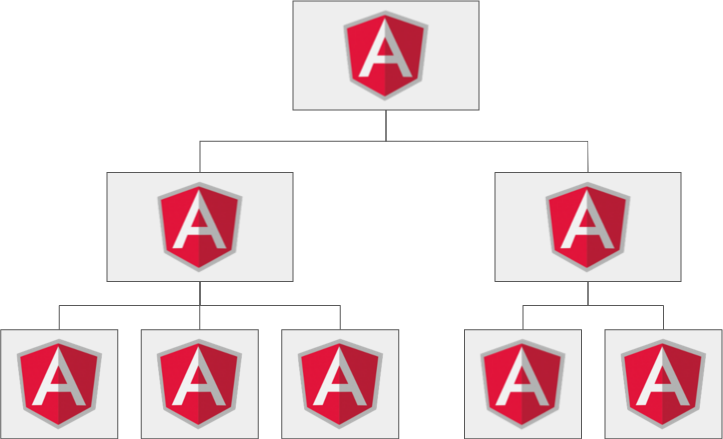
How do we proceed ?
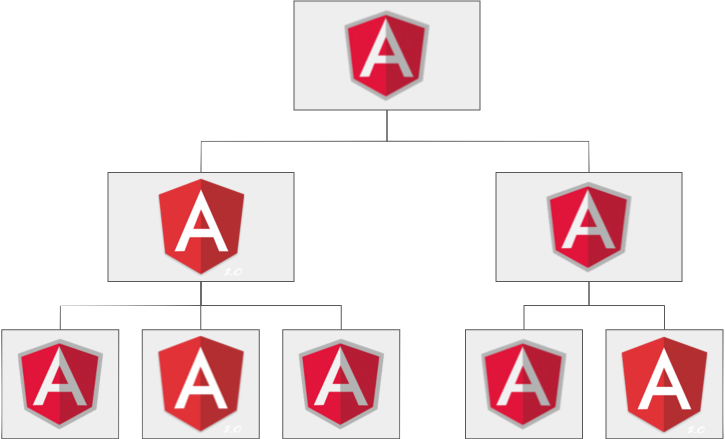
How do we proceed ?

My Opinion ?
The most important requirement to do the migration is...
Good coding style in Angular 1.5+ !
When can we use it ?
 Check on Github !
Check on Github !
And what about a demo ?
If we have the time...
Thank you
Any questions ?
Say if you like this presentation ?

http://goo.gl/j1UmGA

